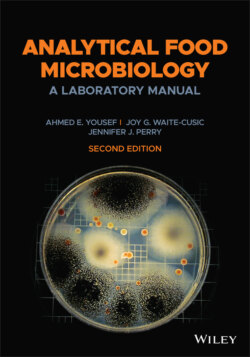Читать книгу Analytical Food Microbiology - Ahmed E. Yousef - Страница 54
Pipetting
ОглавлениеPipetting is an important activity for completing dilutions successfully. Quantitative transfer of broth culture, diluent, homogenized food, liquid food, or similar materials requires accurate pipetting. This can be accomplished by using a pipette in combination with a pipetting device (pipette dispenser, pipetaid, etc.). The pipetting device is an essential tool in analytical laboratories and may vary from simple rubber bulbs to automated pipetters. Simple mechanical pipetting aids are often used with glass or plastic pipettes. These pipettes, often referred to as serological pipettes, are maintained sterile in canisters or individual wrappers. In this book, it is suggested that individually wrapped sterile serological pipettes, along with a hand‐held pipette pump, are used to make the initial dilution (from the homogenized food) in most exercises.
For convenience and consistency, quantitative and aseptic transfer of liquid in microbiological laboratories is accomplished using variable‐volume semiautomatic micropipetters (e.g., Eppendorf pipettes or Gilson Pipetman), in combination with matching sterile pipette tips. These micropipetters are capable of handling specific ranges of liquid volume and the 1000 μl and100 μl are the most popular sizes in microbiological laboratories. Tips matching these sizes are packed in autoclavable box‐racks. The packaged tips are autoclaved before use and disposed of appropriately after use. Adjusting micropipetters to desired volumes and accurate pipetting and dispensing of pipetted volumes requires some practice before starting laboratory exercises. Micropipetters should be calibrated regularly to avoid errors in volume measurements.
When transferring a homogenized food (or a culture) to prepare a set of dilutions, a new clean and sterile pipette or pipette tip should be used for each dilution made. Transferring these dilutions to agar plates can be done using one of two approaches. Starting with the lowest dilution (i.e., most concentrated) requires the use of a new pipette or tip for each dilution transferred. However, a single pipette or pipette tip may be used to transfer multiple dilutions provided the analyst starts with the highest dilution, proceeding to the lowest dilution (i.e., from the least to the most concentrated). If the latter approach is followed, caution should be exercised to avoid contaminating the pipette or the tip during this multistep use. Additionally, plates must be spread with no delay to prevent inoculum from being absorbed into agar before proper distribution across agar surface.
